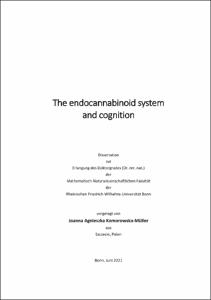Online-Ausgabe in bonndoc: https://nbn-resolving.org/urn:nbn:de:hbz:5-65014
urn: https://nbn-resolving.org/urn:nbn:de:hbz:5-65014,
author = {{Joanna Agnieszka Komorowska-Müller}},
title = {The endocannabinoid system and cognition},
school = {Rheinische Friedrich-Wilhelms-Universität Bonn},
year = 2022,
month = jan,
note = {THC-treatment differentially alters spines dynamics in old and young mice
The endocannabinoid system (ECS) is a neuromodulatory system involved in cognitive processes. Increasing the ECS tone with low-dosage THC - a potent agonist of two main cannabinoid receptors (CB1R and CB2R) – has been shown to restore the diminished cognitive abilities of old mice back to the levels of young mice. In contrast, the same treatment in young mice had an opposite or no effect. In old mice, changes in cognition were accompanied by altered gene expression profile. Among others, upregulation of genes encoding synaptic proteins. Thus, pending the question how does THC treatment influences synapses and their dynamics.
We examined the effects of chronic low-dose THC treatment on synapses by following up on the same dendritic spines before, during, and after the THC treatment using in vivo chronic imaging in 3-month and 18-month old mice. Subsequently, in 18-month old animals we investigated THC-evoked changes in microglia activity as a possible mechanism behind observed changes in the spine dynamics.
We found that the timing and direction of the THC effect was age-dependent. In 18-month old mice, THC treatment increased spine density and spine stability, while decreasing spine dynamics. Investigation of microglia activity revealed that THC treatment decreased microglia phagocytic activity and contacts between microglia and neurons. In contrast, in 3-month old mice THC treatment only temporarily increased spine dynamics and thus decreased spine stability.
Taken together, our investigations indicate that THC treatment differentially alters spine dynamics in young and old mice possibly through the modulation of microglial activity.
Cannabinoid receptor 2 and cognition
Although the cannabinoid receptor 2 (CB2R) is often thought to play a role mainly outside the brain, several publications have comfirem the presence of CB2R on hippocampal principal neurons. Activation of CB2R produces a long-lasting membrane potential hyperpolarization, alters the input/output function of CA2/3 principal neurons and produces alterations in gamma oscillations. However, other cellular, molecular and behavioral consequences of hippocampal CB2R signaling have not been studied in detail.
Here, we investigated the role of CB2R in cognition in two different aspects. First, we focused on age-related changes in the CB2R knockout mice (CB2R-/-) using a series of behavioural paradigms testing memory and anxiety-like behaviour. Second, we investigated gender-specific alterations in CB2R-/- mice in the context of social memory and synaptic architecture using immunohistochemical stainings of synaptic proteins. Our investigation covered synapsin-I, vesicular GABA transporter (vGAT) and vesicular glutamate transporter (vGLUT1).
We found that CB2R-/- mice had only a minor age-dependent alteration in social memory. In the partner recognition task, 3-month and 12-month old mice performed worse and 18-month old mice preformed better than their age-matched controls. At the same time, we noticed that CB2R-/- mice exhibited an age-independent decrease in anxiety-like behaviours. Furthermore, we found that the deletion of CB2R lead to increased synapsin-I signal and particle density, as well as increased vGAT signal in the hippocampus. This phenotype was restricted to females. We confirmed an impairment of social memory in 6-month old CB2R deficient mice, observed in both genders. Our results thus demonstrate that the lack of CB2R leads to changes in the hippocampal synaptic landscape and reveals an important gender-specific difference in endocannabinoid signaling.
Our studies support a significant role of the CB2R in modulation of different types of memory despite its low expression levels in the brain and provides more insight into a gender-specific role of CB2R in synaptic architecture.},
url = {https://hdl.handle.net/20.500.11811/9566}
}






